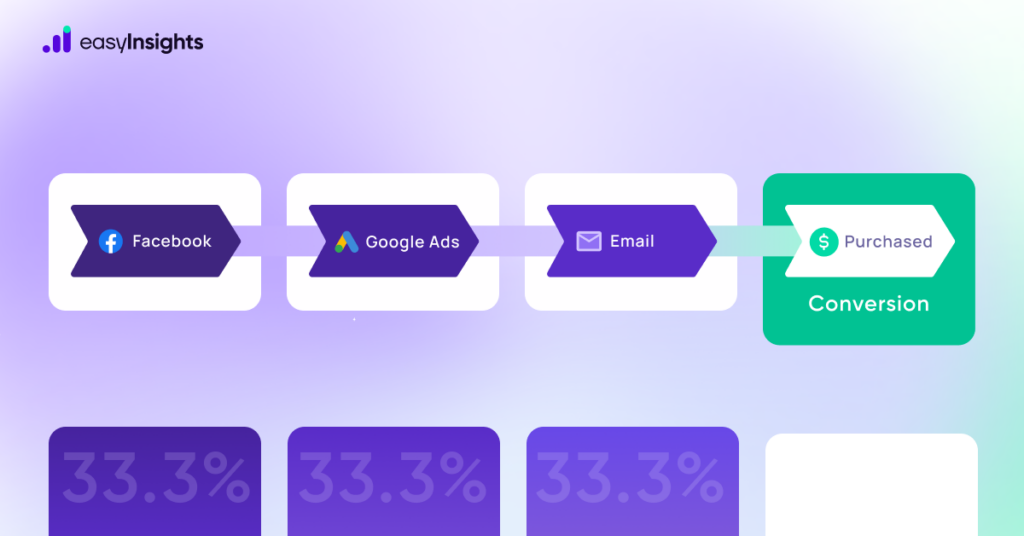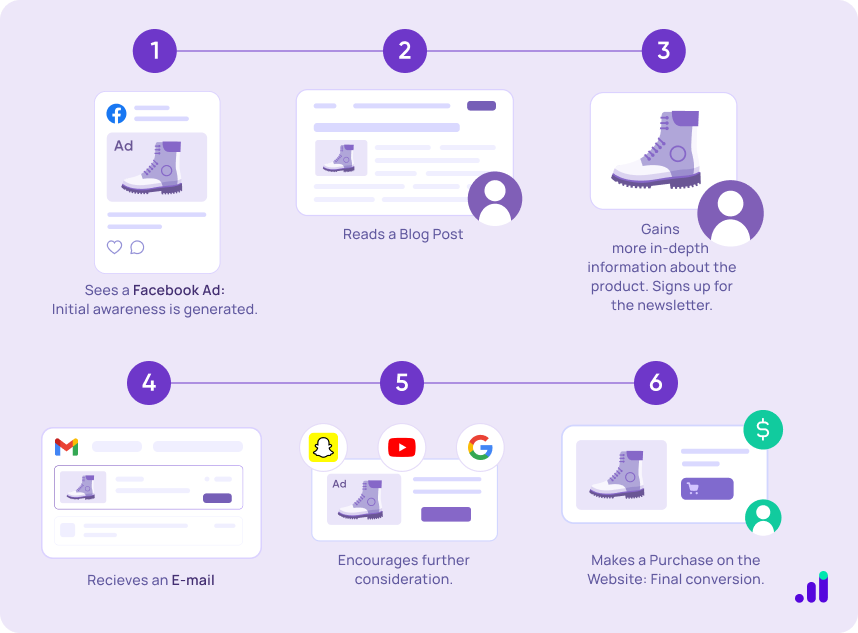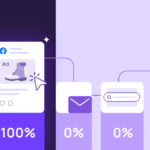
Understanding the impact of each interaction in the customer journey is essential for optimizing campaigns and maximizing ROI. The Linear Attribution Model offers a more balanced approach among the various attribution models available.
It does this by evenly distributing credit across all interactions. That being said its simplicity and holistic view are beneficial, it is essential to recognize its limitations and to use it in conjunction with other models for better insights. Understanding when and how to apply the Linear Attribution Model can allow marketers to allocate resources better, optimize campaigns, and drive more effective marketing outcomes.
Jump ahead to:
What is the Linear Attribution Model?
The linear attribution model is a multi-touch attribution approach that distributes credit for a conversion equally across all consumer interactions with a brand leading up to a purchase. These are regarded as more accurate models as a result. Unlike single-touch models that assign all credit to the first or last interaction, the linear model recognizes the value of each interaction in the customer journey.
How Does the Linear Attribution Model Work?
The Linear Attribution Model calculates the credit for conversions by distributing it equally among all the touchpoints a customer interacts with before converting.
- Identify Touchpoints: This involves listing every interaction a customer has with your brand leading up to the conversion. It can include website visits, ad clicks, social media engagements, email interactions, etc.
- Calculate Weight per Touchpoint: Here’s the formula to determine the credit assigned to each touchpoint.
- Weight per Touchpoint = 1 / Total Number of Touchpoints

Example: Consider a customer who interacts with a brand through multiple channels before making a purchase:
- Sees a Facebook Ad: Initial awareness is generated.
- Reads a Blog Post: Gains more in-depth information about the product.
- Receives an Email: Encourages further consideration.
- Makes a Purchase on the Website: Final conversion.
Here you can see there are 3 touchpoints (Facebook ad, Blog post, Email), each touchpoint weight would be: 1 / 3 = 0.333 (or 33.33%)
Advantages of the Linear Attribution Model
The Linear Attribution Model offers several advantages for marketers, particularly when understanding the overall customer journey and optimizing marketing efforts. Here are some of the key benefits:
- Balanced Perspective: By giving equal credit to all interactions, the Linear Attribution Model provides a balanced view of the customer journey.
- Improved Budget Allocation: With a clearer understanding of each interaction’s role, marketers can make more informed decisions about where to allocate their budgets to maximize return on investment.
- Balanced Credit Allocation: It helps marketers understand the overall contribution of different channels and strategies, leading to more informed decision-making.
- Improved Strategic Planning: Insights from the linear attribution model can guide more balanced and strategic marketing plans that enhance the entire customer journey, rather than focusing on individual stages.
- Easy to Understand: Attribution models can sometimes be complex, but linear attribution is relatively straightforward. Here each interaction gets the same credit, giving you insight into the overall performance of your marketing efforts.
Disadvantages of the Linear Attribution Model
While the Linear Attribution Model offers a balanced view, it has some drawbacks to consider. Here are some of the limitations to be aware of:
- Equal Weight Issue: It does not account for the varying influence of different interactions. For example, a final interaction that directly leads to a conversion may be more impactful than an initial awareness interaction, but both are given equal credit.
- Potential Budget Misallocation: Marketing budgets might be spread too thinly across all channels, rather than focusing on those with the most significant impact on conversions.
- Oversimplification: By distributing credit equally, the model oversimplifies the complexities of the customer journey. It does not reflect the true impact of each interaction, which can vary significantly in different contexts.
- Not Ideal for Short Sales Cycles: For businesses with short sales cycles, where certain interactions play a much more significant role, the linear model may not accurately reflect the importance of those interactions.
- Difficulty in Optimization: Since every interaction receives the same credit, it can be challenging to identify which specific interactions are driving the most value. This makes it harder to optimize marketing strategies based on performance.
Best Practices for Using the Linear Attribution Model
Here are some best practices to get the most out of the Linear Attribution Model:
- Combine with Other Models: To gain deeper insights, use the Linear Attribution Model alongside other models like Time Decay or Position-Based Attribution.
- Analyze Channel Performance: Regularly review the performance of each channel to understand how they collectively drive conversions, adjusting strategies as needed.
- Customize Weighting: While the linear model assigns equal credit to all interactions, consider customizing the weights assigned to each interaction based on your business goals and specific customer behavior patterns. This can help better reflect the varying influence of different interactions.
- Segmentation Analysis: Segment your audience based on key attributes such as demographics, behavior, or purchase history, and analyze how different segments interact with your marketing channels. This can reveal insights into which interactions are most effective for different audience segments.
Leveraging Tools for Linear Attribution Analysis
While the linear attribution model offers a balanced perspective on customer journeys, implementing and analyzing it can involve some technical complexities. Thankfully, various marketing analytics tools and platforms can streamline the process and provide valuable insights.
- EasyInsights: This platform focuses on attribution modeling and data enrichment. It leverages server-side tracking to gather first-party data and provides comprehensive attribution insights, including support for the linear attribution model. EasyInsights provides attribution reports that track the effectiveness of your marketing campaigns across channels, helping you assess their contribution to conversions when viewed through the lens of linear attribution.
- Google Analytics: A widely used platform offering robust reporting features. Its multi-channel funnel reports allow you to visualize customer interactions across different touchpoints, aiding in understanding how various channels contribute to conversions within the linear attribution framework.
- Adobe Analytics: A comprehensive analytics platform with advanced attribution modeling capabilities. It provides granular data on user behavior and allows for custom attribution model configurations, including linear attribution.
- HubSpot Marketing Attribution A marketing platform offering marketing automation features alongside built-in analytics.
- Marketo Engage: Another marketing automation platform that offers campaign attribution reporting. You can leverage Marketo to track how leads interact with your marketing efforts across different channels and understand their journey toward conversion within a linear attribution model.
When to Use the Linear Attribution Model
The Linear Attribution Model shines in specific situations where understanding the cumulative impact of all touchpoints is valuable. Here are some key scenarios where it can be a good choice:
- E-commerce: When navigating through an e-commerce website, a shopper interacts with multiple touchpoints before making a purchase. These interactions can be complex. The linear attribution model recognizes the significance of each interaction, offering a balanced view of the customer journey.
- Optimizing Product Pages for Conversions- Shoppers before making a purchase navigate a web of touchpoints across the sales funnel before making a purchase decision. The Linear Attribution Model acknowledges this complexity by assigning equal weight to all touchpoints a customer encounters on their path to conversion. This balanced perspective ensures no interaction goes unnoticed, providing a clearer picture of the entire customer journey.
- Understanding Cart Behavior with Linear Attribution- Linear attribution sheds light on the role of cart additions and abandonments within the purchase process. It allows you to assess the impact of these actions and identify potential roadblocks in your checkout flow. By analyzing frequently abandoned carts alongside product page interactions, you can uncover patterns in customer behavior.
- Content Marketing: The linear attribution model provides valuable insights for optimizing your content marketing efforts. By analyzing data from all marketing channels contributing to conversions, you can gain a comprehensive understanding of how your content strategy performs. This goes beyond simply measuring blog sign-ups. By focusing on engagement metrics like views, reading time, and comments, you can identify the kind of content that resonates most with your audience.
- Social Media Influence: The linear attribution model also recognizes the power of social media in building brand awareness. By tracking social media shares, mentions, and engagements alongside website visits and conversions, you can gain a clearer picture of the role social media plays in your marketing mix. Analyzing these metrics through the lens of linear attribution allows you to identify influential content types and channels. This empowers you to optimize your social media presence for broader reach, brand loyalty, and ultimately, increased conversions.
Additional Reading: Everything You Need To Know About Marketing Attribution Models
To Conclude
The Linear Attribution Model is a powerful tool for understanding the collective impact of all interactions in the customer journey, optimizing overall marketing efforts, and ensuring balanced credit distribution across channels. Recognizing the value of each touchpoint supports comprehensive marketing strategies and simplifies attribution analysis. However, to gain a more nuanced understanding of the customer journey, it is crucial to use this model in conjunction with other attribution methods, analyze the full conversion path, and continuously monitor and adjust strategies. This holistic approach will enable marketers to allocate resources effectively, optimize campaigns across all customer journey stages, and ultimately drive more successful marketing outcomes.
Effective attribution requires accurate and comprehensive data to function properly. EasyInsights offers a reliable solution for attribution challenges, leveraging server-side tracking to gather first-party data. EasyInsights can help you implement the right attribution strategy for your marketing efforts by providing detailed insights and robust analytics.
To know more, book a demo today!








